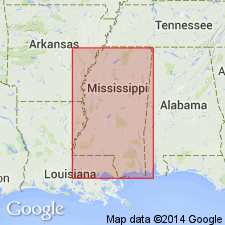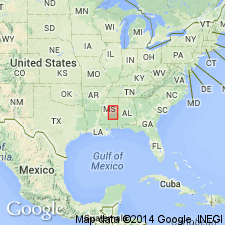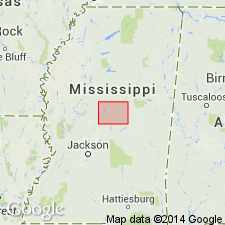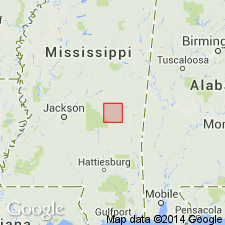
- Usage in publication:
-
- Zilpha clay member
- Modifications:
-
- Original reference
- Dominant lithology:
-
- Clay
- AAPG geologic province:
-
- Mid-Gulf Coast basin
Summary:
[Revised chart, published in AAPG Bull., submitted Oct. 1940 (chart originally published in Mississippi Geol. Soc. Gdbk. 1, Feb. 1940); Mississippi Geol. Soc. Gdbk. 2, Mar. 1940, p. 3, 11-12, chart.] Zilpha clay member of Lisbon formation of Claiborne group. Gray-white to chocolate-brown clay; sandy at top and glauconitic at base. Thickness 60+/- feet. Underlies Kosciusko sand member and overlies Winona sand member (both of Lisbon). Name credited to Raymond Moore. [Age is middle Eocene.]
Source: Publication; US geologic names lexicon (USGS Bull. 1200, p. 4338-4339).

- Usage in publication:
-
- Zilpha clay
- Modifications:
-
- Principal reference
- Revised
- AAPG geologic province:
-
- Mid-Gulf Coast basin
Thomas, E.P., 1942, The Claiborne: Mississippi Geological Survey Bulletin, no. 48, 96 p.
Summary:
Pg. 33-40, fig. 1, pls. 1, 2, profiles A, B, C. Zilpha raised to formation rank in Claiborne group. Thickness at designated type locality 54 feet; upper contact not exposed. Overlies Winona greensand and underlies Kosciusko formation.
Type locality: along county road at Bucksnort Hill, 1.5 mi north of Zilpha Creek and near center sec. 8, T. 16 N., R. 6 E., northwestern Attala Co., western MS.
Source: US geologic names lexicon (USGS Bull. 1200, p. 4338-4339).

- Usage in publication:
-
- Zilpha formation
- Modifications:
-
- Revised
- AAPG geologic province:
-
- Mid-Gulf Coast basin
Summary:
Zama member defined and assigned to base of Zilpha formation. Includes all strata in Zilpha above top of Winona formation and below top of a prominent glauconite bed that defines top of formation.
Source: GNU records (USGS DDS-6; Reston GNULEX); US geologic names lexicon (USGS Bull. 1350, p. 844).

- Usage in publication:
-
- Zilpha Formation
- Modifications:
-
- Overview
- AAPG geologic province:
-
- Mid-Gulf Coast basin
Summary:
In Newton County, Mississippi, Zilpha Formation of Claiborne Group is exposed at the surface as a dark yellowish-brown to grayish-brown, sandy, silty, glauconitic, carbonaceous clay, with sand lenses and thin beds in the lower portion. In the subsurface, the Zilpha is dark yellowish-brown, sandy, silty clay. Thickness ranges from 12 to 68 feet, varying inversely with that of the underlying Winona. Contact with the Winona is conformable showing only an increase in the glauconite and quartz percentages. Contact with the overlying Kosciusko Formation is also gradational. Depositional environment interpreted as marine shelf and prodelta. Report includes geologic map; measured sections; stratigraphic column.
Source: Modified from GNU records (USGS DDS-6; Reston GNULEX).
For more information, please contact Nancy Stamm, Geologic Names Committee Secretary.
Asterisk (*) indicates published by U.S. Geological Survey authors.
"No current usage" (†) implies that a name has been abandoned or has fallen into disuse. Former usage and, if known, replacement name given in parentheses ( ).
Slash (/) indicates name conflicts with nomenclatural guidelines (CSN, 1933; ACSN, 1961, 1970; NACSN, 1983, 2005, 2021). May be explained within brackets ([ ]).

